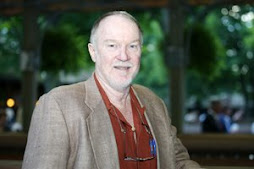Thoroughbred Pedigree, Genetics, and Performance Conference
2:00 p.m.
The conference now devolves into breakout sessions with several different speakers at the same time. Personally, I've had enough and I'm going to sign off here.
The biggest difference for me between this year's conference and the first one last year is that it was much more blatant that virtually all of the presenters represent commercial ventures and they have something to sell us. Given who the organizers are and the economic system we live in, this was never going to be pure science, but it is a little disconcerting to feel like the presenters are as or more interested in hawking products as disseminating information.
Cheers!
JPS
1:00 p.m.
Steve Roman begins the afternoon session.
Roman will cover his ideas on aptitudinal type. First begins by comparing different definitions of speed....i.e. final time, average speed, fractions. Stamina....speed over a distance or winning over a distance? Somebody has to win the race, regardless of speed. Any horse can run any distance if you give it enough time.
American time records fall in an almost straight correlation line, projected from the shorter distances. Roman calls that line the genetic frontier of speed. Although the times have changed, the shape and linearity of the line has not changed since 1976. That measures an increase in speed over the last 35 years.
Dosage not a breeding theory, not a handicapping scheme, or a betting scheme for Ky. Derby.
Defines dosage as a methodology applied to large populations for classifying pedigrees by aptitudinal type, as a research tool correlating type with real world performance.
Roman produces good slides that show that dosage index and center of distribution decline with distance both in the U.S. and every other country he's tested. The key point is that the line is highest for American dirt horses, which means, as Roman says that American dirt horses are the most speed bred horses in the world.
Roman spends a lot of time defending the dual qualifier concept, despite his earlier claim that dosage is not a handicapping tool. Unfortunately he has to expand the concept to include horses like Smarty Jones who were not rated on the Experimental Free Handicap.
11:15 a.m.
Jeff Seder of EQB up next on heart ultrasounds.
Begins by showing average for the breed statistics as a baseline level. Believes a lot of performance has to do with who is really trying and which ones will put up with pain.
Talking about a published study on heart ultrasound.
Study based on over 7k horses, divide those into categories, colts fillies, US, foreign, dirt-turf, etc.
How do you use heart data
Size of left ventricle at relaxation....fillies and colt sizes very different. Growth curves are different. Train diligently to insure reproducibility of heart measurements. Size and weight of the horse matter. Age is also critical to get accurate measurements. Thickness of the septal wall is also very important.
Horses ranking above the 75th percentile in left ventricle size earn more. No surprise.
These measures do tend to differ by sire and sire line. No surprise that Northern Dancer and sons produced very high percentages of big hearts and thick septal walls.
Trying to figure out which sires are going to produce big hearts is very hard to predict. Dynaformer for example tends to produce smaller hearts but with thick septal walls.
Lunch break.
10:00 a.m.
Bob Fierro and Jay Kilgore up next of DataTrack international on stride length
As usual, raconteur Bob starts off with a funny story about a trip to Argentina, where the mythical national hero shares his last name. Then he describes how DataTrack invented their Breeze Figs, which rate horses according to stride length and other measures at juvenile sales. DRF now publishes daily Breeze Figs for 2yos for their first four starts.
Graded SW have an average stride length of 24 feet or greater....drop down a level to listed winners and it's under 24 feet.....and so on.
Jay Kilgore gives some details on how their video analysis of stride efficiency works with stills of digital video. Fascinating video showing how horses feet move as they run. The computer attaches points as it were to the horse's feet, nose, etc. to measure efficiency of movement. Video showing lines that the points make through space are visually very effective.
9:40 a.m.
After several frustrating hours of being unable to connect to the wireless internet here at the Griffin Gate Hotel in Lexington, I am finally connected and ready to resume live-blogging.
John Seaman of Cecil Seaman and Co. just finished his presentation on breeding type to type.
Most of John's discussion was about their measurement of body length as an indicator of overall body size. He presented numerous slides showing how similar body types tend to predominate in the pedigrees of successful racehorses. This tends to be the basic message of biomechanics gurus. Mating horses with similar body types and measurements tends to work better than matings of dissimilar types. This will not be news to anyone who has been doing matings for 40 years. ....or, indeed, considerably less than that.
More to follow
The Horse Racing blog has moved
8 years ago

